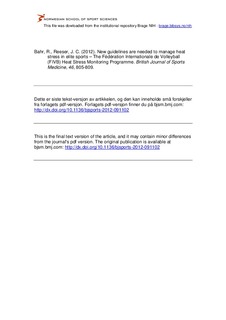| dc.contributor.author | Bahr, Roald | |
| dc.contributor.author | Reeser, Jonathan C. | |
| dc.date.accessioned | 2013-04-11T05:55:48Z | |
| dc.date.available | 2013-04-11T05:55:48Z | |
| dc.date.issued | 2012-06-09 | |
| dc.identifier | Seksjon for idrettsmedisinske fag / Department of Sports Medicine | |
| dc.identifier.citation | British Journal of Sports Medicine. 2012, 46, 805-809 | no_NO |
| dc.identifier.issn | 1473-0480 | |
| dc.identifier.uri | http://hdl.handle.net/11250/170938 | |
| dc.description | I Brage finner du siste tekst-versjon av artikkelen, og den kan inneholde ubetydelige forskjeller fra forlagets pdf-versjon. Forlagets pdf-versjon finner du på bjsm.bmj.com: http://dx.doi.org/10.1136/bjsports-2012-091102 / In Brage you'll find the final text version of the article, and it may contain insignificant differences from the journal's pdf version. The definitive version is available at bjsm.bmj.com: http://dx.doi.org/10.1136/bjsports-2012-091102 | no_NO |
| dc.description.abstract | BACKGROUND:
There seems to be a discrepancy between the available heat stress guidelines and the actual risk of heat-related illness among professional beach volleyball players competing under hot and humid conditions.
OBJECTIVE:
To monitor heat stress and record cases of heat-related medical forfeits on the Swatch FIVB Beach Volleyball World Tour.
METHODS:
The FIVB Heat Stress Monitoring Protocol covered events on the FIVB Beach Volleyball World Tour and FIVB Beach Volleyball World Championships during the 2009, 2010 and 2011 seasons (51 events, most of these double gender). The protocol consisted of (1) measuring the Wet Bulb Globe Temperature (WBGT) on centre court prior to the start of every match, and (2) recording any heat-related medical forfeits during the tournament.
RESULTS:
Data were collected during 48 of 51 events. There were nine events where the peak WBGT exceeded the US Navy Black flag conditions of >32.3°C and an additional two events where the peak WBGT exceeded 31°C, (meeting Red flag conditions.) In two events, the average WBGT equalled at least 31°C. One case of a medical forfeit related to heat stress was recorded over the 3-year surveillance period: an athlete whose fluid balance was compromised from a 3-day bout of acute gastroenteritis.
CONCLUSION:
The incidence of significant heat illness among athletes competing on the FIVB Beach Volleyball World Tour appears to be quite low, even though weather conditions frequently result in a WBGT index >32°C. Currently available guidelines appear to be inadequate to fully assess the risk of heat stress and too conservative to inform safety decisions in professional beach volleyball. | no_NO |
| dc.language.iso | eng | no_NO |
| dc.publisher | BMJ Group | no_NO |
| dc.subject | heat stress disorders | no_NO |
| dc.subject | hot temperature / adverse effects | no_NO |
| dc.subject | practice guidelines | no_NO |
| dc.subject | seasons | no_NO |
| dc.subject | volleyball / physiology | no_NO |
| dc.subject | weather | no_NO |
| dc.title | New guidelines are needed to manage heat stress in elite sports – The Fédération Internationale de Volleyball (FIVB) Heat Stress Monitoring Programme | no_NO |
| dc.type | Journal article | no_NO |
| dc.type | Peer reviewed | no_NO |
| dc.subject.nsi | VDP::Social science: 200::Social science in sports: 330::Other subjects within physical education: 339 | no_NO |
| dc.source.journal | British Journal of Sports Medicine | |
| dc.identifier.doi | 10.1136/bjsports-2012-091102 | |
